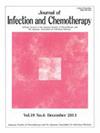In vitro neuraminidase inhibitory concentrations (IC50) of four neuraminidase inhibitors in the Japanese 2023–24 season: Comparison with the 2010–11 to 2022–23 seasons
IF 1.9
4区 医学
Q3 INFECTIOUS DISEASES
引用次数: 0
Abstract
Introduction
To assess the susceptibility of epidemic influenza viruses to the four most used neuraminidase inhibitors (NAIs) during the 2023–24 influenza season in Japan, we measured the 50 % inhibitory concentration (IC50) of oseltamivir, peramivir, zanamivir, and laninamivir in virus isolates from the sample of 100 patients.
Methods
Viral isolation was done using specimens obtained before and after treatment, with the type/subtype determined by RT-PCR using type- and subtype-specific primers. IC50 values were determined by a neuraminidase inhibition assay using a fluorescent substrate.
Results
The virus isolates included 16 A(H1N1)pdm09, 19 A(H3N2), and 65 B/Victoria-lineage. The geometric mean (GM) IC50 values of pre-treatment samples for oseltamivir, peramivir, zanamivir, and laninamivir were 0.90 nM, 0.62 nM, 1.09 nM, and 2.77 nM for A(H1N1)pdm09; 0.86 nM, 0.67 nM, 1.64 nM, and 3.61 nM for A(H3N2); and 16.12 nM, 1.84 nM, 3.87 nM, and 11.35 nM for B/Victoria, respectively. These values were comparable to those from the previous eleven seasons, and no virus with significantly reduced susceptibility to any of the NAIs was found either before or after drug administration in the 2023–24 season.
Conclusions
These results indicate that susceptibility to these four NAIs has been maintained across the three influenza types/subtypes over the past fourteen seasons in Japan.
日本2023-24季节四种神经氨酸酶抑制剂的体外神经氨酸酶抑制浓度(IC50):与2010-11和2022-23季节的比较
为了评估2023-24年日本流感季节期间流行性流感病毒对四种最常用的神经氨酸酶抑制剂(NAIs)的易感性,我们测量了100例患者样本中分离的病毒中奥司他韦、帕拉米韦、扎那米韦和拉尼诺米韦的50%抑制浓度(IC50)。方法:采用治疗前后标本进行病毒分离,采用型特异引物和亚型特异引物进行RT-PCR检测病毒型/亚型。采用荧光底物进行神经氨酸酶抑制试验,测定IC50值。结果:分离出A(H1N1)pdm09病毒16株,A(H3N2)病毒19株,B/ victoria病毒65株。奥司他韦、帕拉米韦、扎那米韦和拉那米韦预处理样品的A(H1N1)pdm09的几何平均IC50值分别为0.90 nM、0.62 nM、1.09 nM和2.77 nM;A(H3N2)为0.86 nM、0.67 nM、1.64 nM和3.61 nM;B/Victoria分别为16.12 nM、1.84 nM、3.87 nM和11.35 nM。这些值与前11个季节的值相当,并且在2023-24赛季用药前后均未发现对任何NAIs易感性显著降低的病毒。结论:这些结果表明,在过去的14个季节中,日本的三种流感类型/亚型对这四种NAIs的易感性一直保持不变。
本文章由计算机程序翻译,如有差异,请以英文原文为准。
求助全文
约1分钟内获得全文
求助全文
来源期刊

Journal of Infection and Chemotherapy
INFECTIOUS DISEASES-PHARMACOLOGY & PHARMACY
CiteScore
4.10
自引率
4.50%
发文量
303
审稿时长
47 days
期刊介绍:
The Journal of Infection and Chemotherapy (JIC) — official journal of the Japanese Society of Chemotherapy and The Japanese Association for Infectious Diseases — welcomes original papers, laboratory or clinical, as well as case reports, notes, committee reports, surveillance and guidelines from all parts of the world on all aspects of chemotherapy, covering the pathogenesis, diagnosis, treatment, and control of infection, including treatment with anticancer drugs. Experimental studies on animal models and pharmacokinetics, and reports on epidemiology and clinical trials are particularly welcome.
 求助内容:
求助内容: 应助结果提醒方式:
应助结果提醒方式:


